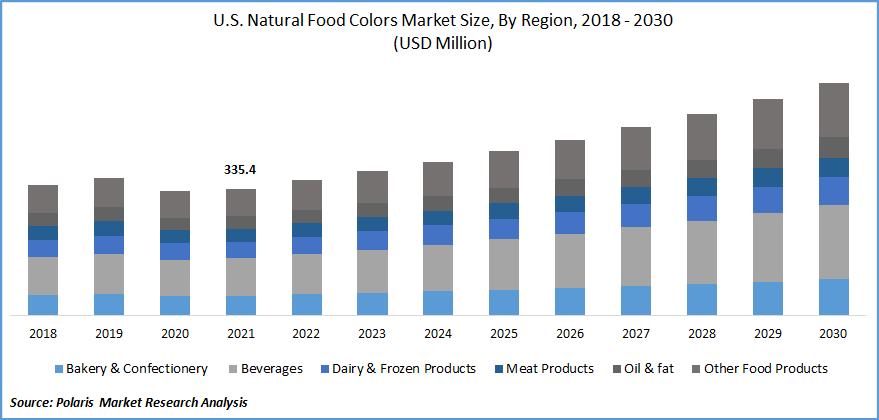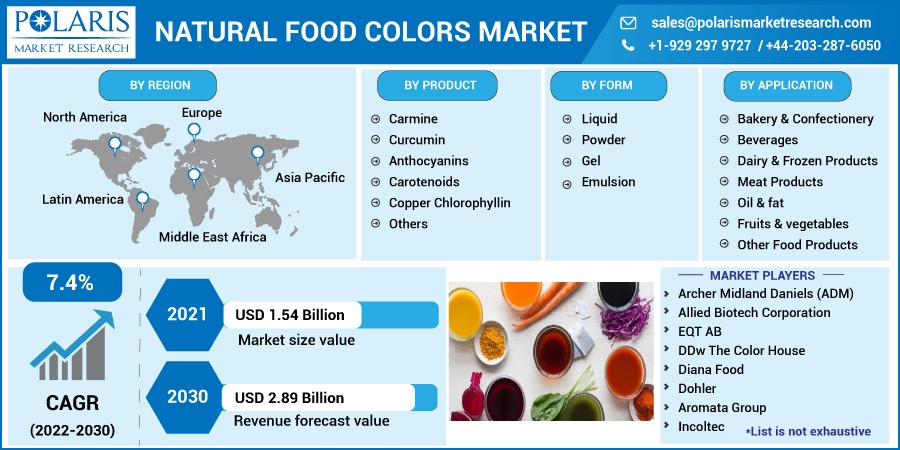
Natural Food Colors Market Share, Size, Trends, Industry Analysis Report, By Product (Carotenoids, Curcumin, Anthocyanin, Carmine, Copper Chlorophyllin, Others); By Form; By Application; By Region; Segment Forecast, 2022 - 2030
- Published Date:Apr-2022
- Pages: 101
- Format: PDF
- Report ID: PM1657
- Base Year: 2021
- Historical Data: 2018 - 2020
Report Summary
The global natural food colors market was valued at USD 1.54 billion in 2021 and is expected to grow at a CAGR of 7.4% during the forecast period. The growing pressure from regulatory authorities and consumers for natural and organic ingredients in the consumables is expected to have triggered the adoption of natural colors by the manufacturers even though the high prices of the colors as compared to synthetic ones.
 Know more about this report: request for sample pages
Know more about this report: request for sample pages
The raw materials for natural food colors include fruits & vegetables and natural extracts derived from them. Natural food colors are extracted from different natural sources depending on the coloring needs. However, common raw materials for colors include carrots, oranges, grapes, spinach, nettles, beetroots, and turmeric. Carmine is one of the unique colors, which is derived from an insect. It is extracted from the Armenian cochineal insect, which is the purest form of carmine. However, carmine can be derived from mixing of two or more natural colors.
Natural food colors are extracted from fruits & vegetables and organic sources on account of which the health hazards associated with the colors are negligible. However, there are several health benefits associated with colors that are extracted from vegetables & fruits. As fruits & vegetables contain nutrients that are required by the body in abundance, these nutrients are transferred with the color molecules in the solution during the extraction process.
 Know more about this report: request for sample pages
Know more about this report: request for sample pages
Industry Dynamics
Growth Drivers
There are several regulations on synthetic colors for their use in the food & beverage industry. Synthetic colors are manufactured with chemicals that could be harmful to human consumption. As a result, the demand for natural colors is increasing even though they are more expensive. Furthermore, the growing demand for natural and organic additives is also expected to drive demand.
The health benefits associated with natural food colors are expected to have a positive impact on the market growth. Carotenoids are antioxidants that aid in building body immunity and curcumin has several health benefits and acts as an immunity booster against coronavirus. As a result, the growing awareness of the same among consumers is driving the demand for natural colors.
Report Segmentation
The market is primarily segmented on the basis of product, form, application, and region.
|
By Product |
By Form |
By Application |
By Region |
|
|
|
|
Know more about this report: request for sample pages
Insight by Form
The liquid form segment is expected to grow at a CAGR of 7.9% over the forecast period. The increasing utilization of liquid forms of natural food color in beverage, confectionery, bakery, and savory applications is likely to augment the growth of the natural food colors market over the forecast period. The liquid form of natural food colors is easy to use in a variety of formulation, can be simply dispersed, and are available in different color shades.
The powder form is likely to hold the second-largest market share over the forecast period, followed by liquid. Powder food coloring is a dry form of natural food color with no liquid. Powder food coloring produces the deepest ultra-dark level of color that is ideal for dry mixes. These are widely used in bakery & confectionery products, cereals, frozen desserts, savory products, etc., which is likely to accelerate the demand for the powder form of natural food colors.
Natural food coloring in gel form is also water-based, but it also contains glycerin and corn syrup, making it a semi-thick gel and intense form of food coloring. This is the type of coloring that may be used in almost any recipe, as it won't change the consistency of the mixture. Its easy application is likely to increase the demand for gel forms of natural food colors.
Insight by Product
Carotenoids accounted for 30.1% of the global revenue in 2021. Carotenoids are obtained from microorganisms, algae, plants as well as some animal species. They provide bright yellow, red, and orange colors and are majorly used as food coloring agents. Carotenoid is classified into two categories including xanthophylls and carotenes. The most common xanthophylls are lutein found in corn, egg yolk, honeydew melon, etc., and zeaxanthin is commonly found in green leafy vegetables such as broccoli, spinach, kale, etc.
The emerging therapeutic role and application of curcumin in human diseases, specifically as anti-bacterial and anti-cancer, has played a significant role in market growth. People are ready to pay a higher price for organic food owing to the numerous health benefits associated with them. Customers who want to get the most out of turmeric's beneficial properties are demanding organic turmeric.
The increasing demand for Anthocyanin in the food & beverage industry is propelled by its functional properties such as anti-allergic, anti-diabetic, anti-microbial, anti-inflammatory, and antioxidant. Food and beverage manufacturers are using anthocyanin to enhance the flavor and color of their products in order to meet the need of health-conscious consumers, which is projected to boost the growth of the natural food colors market.
Insight by Application
Bakery & confectionery sector is expected to hold a significant market share in the global food colors market. The increased consumption of bakery & confectionery products such as cookies, doughnuts, cupcakes, rolls, sweet rolls, bread, cakes, biscuits, pies, and coffeecakes, along with the rising health awareness among consumers, is projected to accelerate the demand for natural food colors market.
The beverage industry is expected to account for the largest market share over the forecast period. The demand for natural food colors in the beverage industry is driven by the rising consumer's choice of beverage selection, which is increasingly influenced by the color of the drink itself. Consumers select products more on the basis of appearance than flavor type.
The demand for natural food colors is driven by the increasing trend of responsible consumption where the consumer looks for natural options that are free of colorants and other artificial additives. In dairy applications, the carmine gives excellent red and orange tones. Carmine is also heat and light resistant and adheres well to fruit preparations used in the dairy industry, which in turn, is expected to stimulate the growth of the natural food colors market.
Geographic Overview
North America holds a significant share in the global market and is expected to grow considerably over the projected period. Increasing consumer awareness regarding diseases related to synthetic colors such as cancer and other cardiovascular disorders coupled with the introduction of regulations and laws limiting the use of synthetic dyes is expected to drive the natural food color market over the forecast period.
Multicultural food makers are focusing more on the food standards, convenience aspect, and diverse cuisines, including packaged food of the items. Furthermore, the country's ethnic cuisine demand has been bolstered by a high frequency of tourists, a growing tourism demographic, and an increase in athletic events is expected to increase the demand for natural food colors over the forecast period.
Asia Pacific is expected to be the fastest-growing region in the global natural food colors market over the forecast period. The health-promoting characteristics of natural colors, along with the organoleptic properties of organic goods, are expected to stimulate the demand for the natural food colors market.
Competitive Insights
In July 2019, DDW The Color House acquired the natural food colors business of DuPont to expand its global reach and improve the manufacturing capabilities of the company. However, in 2021, the company was acquired by Givaudan as it enabled the latter to strengthen its leadership in the industry.
Natural Food Colors Market Report Scope
|
Report Attributes |
Details |
|
Market size value in 2021 |
USD 1.54 billion |
|
Revenue forecast in 2030 |
USD 2.89 billion |
|
CAGR |
7.4% from 2022 - 2030 |
|
Base year |
2021 |
|
Historical data |
2018 - 2020 |
|
Forecast period |
2022 - 2030 |
|
Quantitative units |
Revenue in USD million/billion and CAGR from 2022 to 2030 |
|
Segments covered |
By Form, By Product, By Application, By Region |
|
Regional scope |
North America, Europe, Asia Pacific, Latin America; Middle East & Africa |
|
Key companies |
Archer Midland Daniels (ADM), Allied Biotech Corporation, EQT AB, DDw The Color House, Diana Food, Dohler, Aromata Group, Incoltec, GNT Group, DSM, Naturex, LycoRed, and Sensient Technologies. |
License and Pricing
Purchase Report Sections
- Regional analysis
- Segmentation analysis
- Industry outlook
- Competitive landscape
Connect with experts
Suggested Report
- Food Fortifying Agents Market Share, Size, Trends, Industry Analysis Report, 2022 - 2030
- Traffic Management Market Share, Size, Trends, Industry Analysis Report, 2022 - 2030
- Pharmaceutical Robots Market Research Report, Size, Share & Forecast by 2019 - 2026
- Plastic Resins Market Share, Size, Trends, Industry Analysis Report, 2021 - 2028
- Cyclopentane Market Share, Size, Trends, Industry Analysis Report, 2022 - 2030

